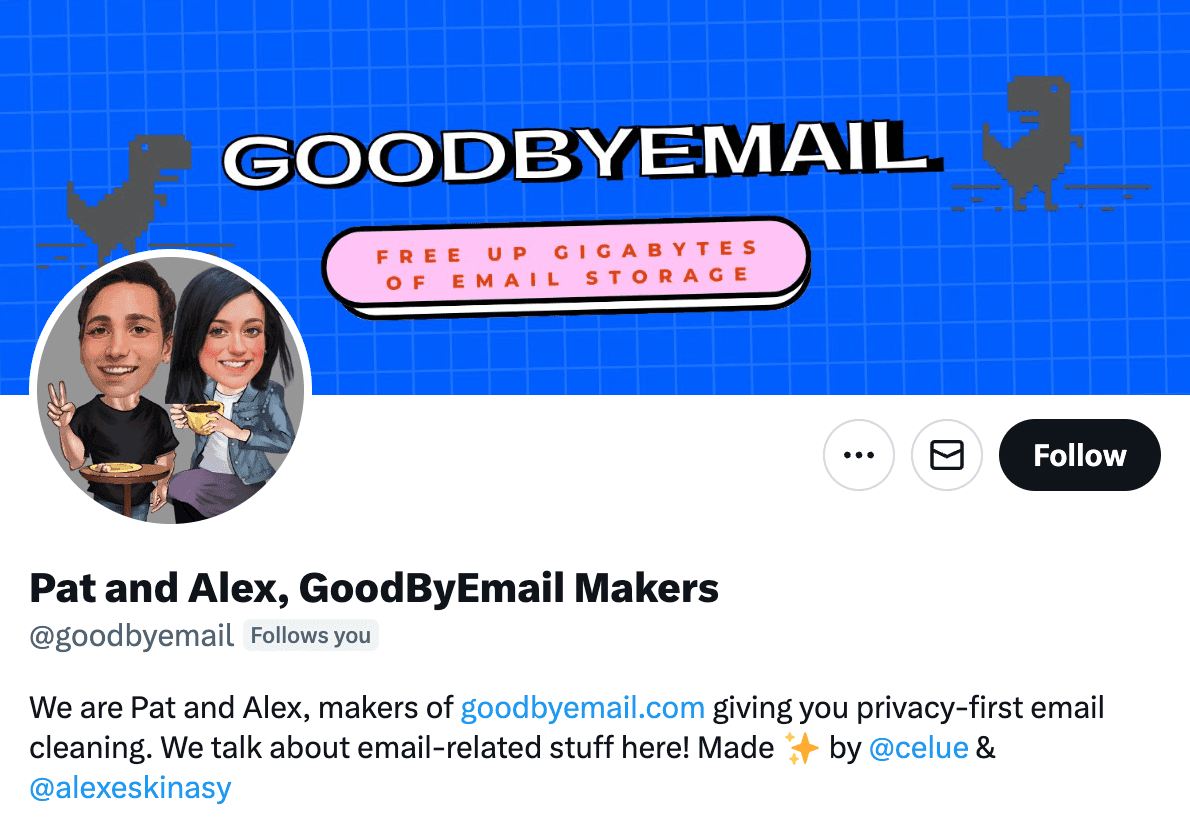How to Clean Up Your Gmail Storage in
The quickest way to clear your Gmail storage and get rid of "Gmail Storage Full Not Receiving Emails" errors
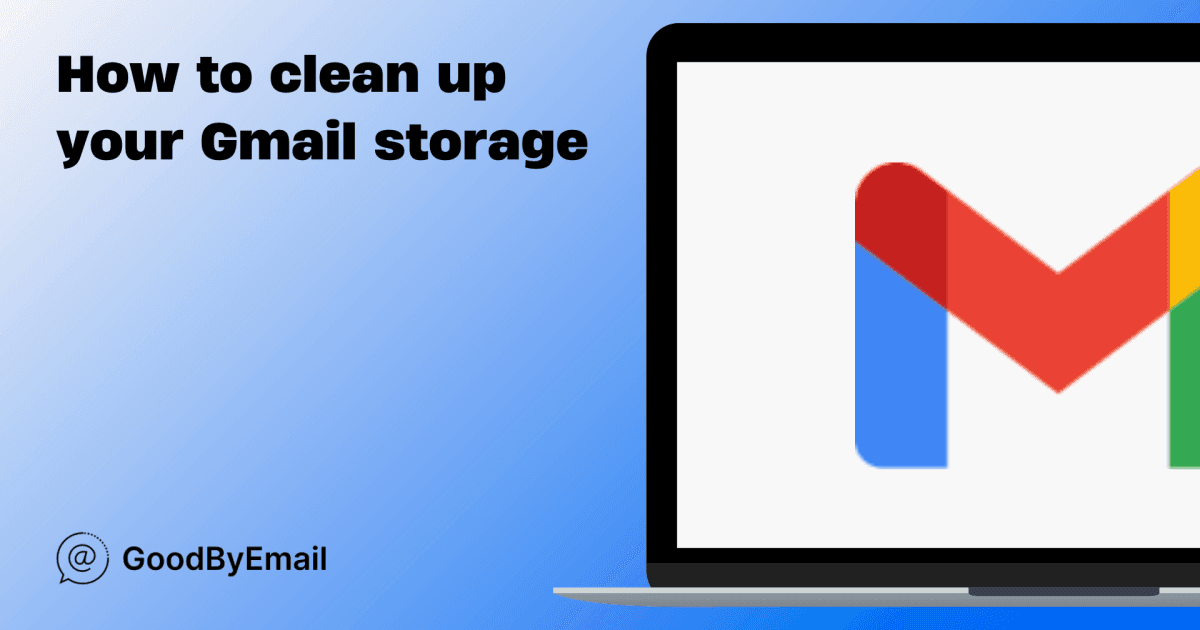
Imagine your Gmail account as a super messy room. Now, imagine Google like the stern parent telling you it's time to tidy up. If your digital closet, i.e., your Gmail account, is brimming over with emails, Google is nudging you to put your virtual house in order. This started in 2021 when Google started to play hardball with its storage policy, leaving users with no choice but to get their act together.
Your Gmail account gives you 15GB of storage space, like a suitcase for your digital stuff. This space is divided between Google Drive, Gmail, and Google Photos. However, the era of generous free Photos storage has ended. You're now left with no option but to roll up your sleeves and declutter. We're sure you don't want Google to take matters into its own hands and start tossing things out!
How to fix the "Gmail Storage Full" & "Gmail Out of Storage" errors?
Let's start our cleaning spree by looking at your Gmail inbox, especially those old emails.
Before we start, make sure you're logged into Gmail. You can use your Chrome browser, Mac, Windows PC, Android tablet, or iPad. These steps work best if you're using the web version of Gmail.
First, let's find out how much space your emails are taking up. Scroll down to the bottom of your Gmail page. There, you'll see a small meter showing how much space your Google stuff is using.
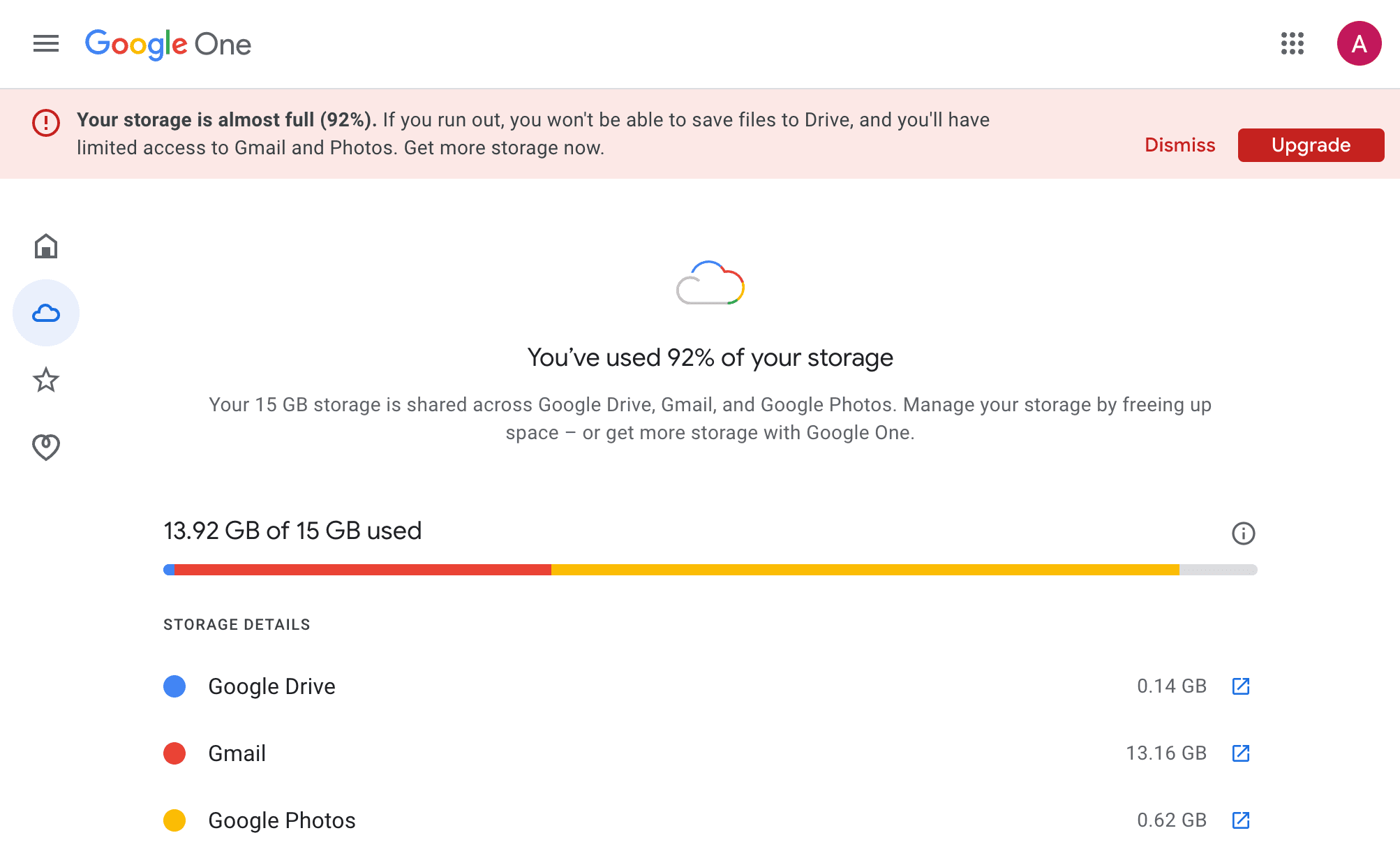
Moving on, you now have two options:
- Delete random emails in Gmail and hope they free up enough storage space.
- Use GoodByEmail, a specialized, privacy-first app that - with the help of a lot of algorithmic power - analyzes your inbox and identifies the "Top Offenders". These are the email senders that take up most inbox space. You can also unsubscribe from mailing-list senders with one-click directly from the app. GoodByEmail is the only truly private email cleaner on the market. Your emails never leave your device. There's no need to share your email login credentials or grant access to your inbox.
Option 1 — Deleting Random Emails
How to Quickly Delete Old Emails to Clean Up Gmail
It's time to start cleaning!
Gmail categorizes emails under different tabs: Primary, Social, Promotions, Updates, and Forums. Google thinks your Primary tab has the important stuff, and the rest may not be as important. But sometimes, those other tabs hold treasures old newsletters, forum updates, or old notifications from social networks. You know, the kind of stuff you want to hold on to (even if just to reminisce).
A commonly suggested approach is to start by deleting unnecessary emails from the Promotions tab. However, it can be difficult to know where to start without knowing how much space these emails are using. Promotions can be a good place to begin, as many of the emails there are likely to be of lesser importance.
If you want to avoid deleting emails randomly, you can use filters to organize your deletions.
Don't Miss Out!
Subscribe to GoodByEmail's newsletter. Our updates are filled with tips on how to manage your inbox.
How to Filter Emails to Selectively Clear Gmail Storage
You can use Gmail's search box to find specific types of emails. It's like being a detective! It can search for more than just words; it can look for certain things to help you find emails you don't need. Here are some handy commands you can use:
- older_than:5m - This shows all emails older than five months. You can change 'm' to 'y' for year or 'd' for day.
- before:02/14/2015 - This shows all emails sent before February 14, 2015.
- filename:pdf - This shows all emails with a PDF file attached.
- has:attachment - This finds all emails with attachments.
- size: or larger: or smaller: - This can find big emails. For example, 'larger:200' will find emails bigger than 200 bytes, while 'larger:13M' will find those larger than 13 megabytes.
- is:important - This shows all emails marked as Important.
- from:Joanna - This finds all emails from Joanna.
Unfortunately, even after all this, you may still not know how much space you saved by deleting those emails. You may also end up deleting emails with large attachments that you really don't want to delete. This means that you may still receive the chilling notification that you are still out of storage space, even a day later.
This brings us to our second option, GoodByEmail, a tool that can genuinely help you reclaim your inbox space.
Option 2 — Using GoodByEmail
How to Mass Delete Emails to Quickly Clean Up Gmail
The problem with Gmail filtering is that it doesn't show you which senders are using up the most storage space.
Shockingly, you've been made believe that large attached files are the main cause of full inboxes. However, the reality is that a large number of small emails can also take up a lot of storage space.
But what if you could know who are the senders that really load up your inbox? GoodByEmail does the heavy number crunching on your inbox and helps you discover the Top Offenders that use up your Gmail storage, using a privacy-first approach (your data is protected and never leaves your device). Here's how it works in a nutshell:
- Scan your Gmail inbox offline using GoodByEmail's privacy-first approach. No OAuth tokens required, and it even works offline! For further information on privacy considerations in email cleaning, check this article.
- Learn how to fix "Gmail out of storage" errors quickly by identifying email senders that are using up the most storage space.
- Unsubscribe & mass delete thousands of emails and clear up Gmail storage.
GoodByEmail's interactive dashboard let's you see who's REALLY taking up space, how many emails they've sent, and when they last emailed you. Some users report their top 10 offenders alone account for between 40-60% of their inbox clutter.
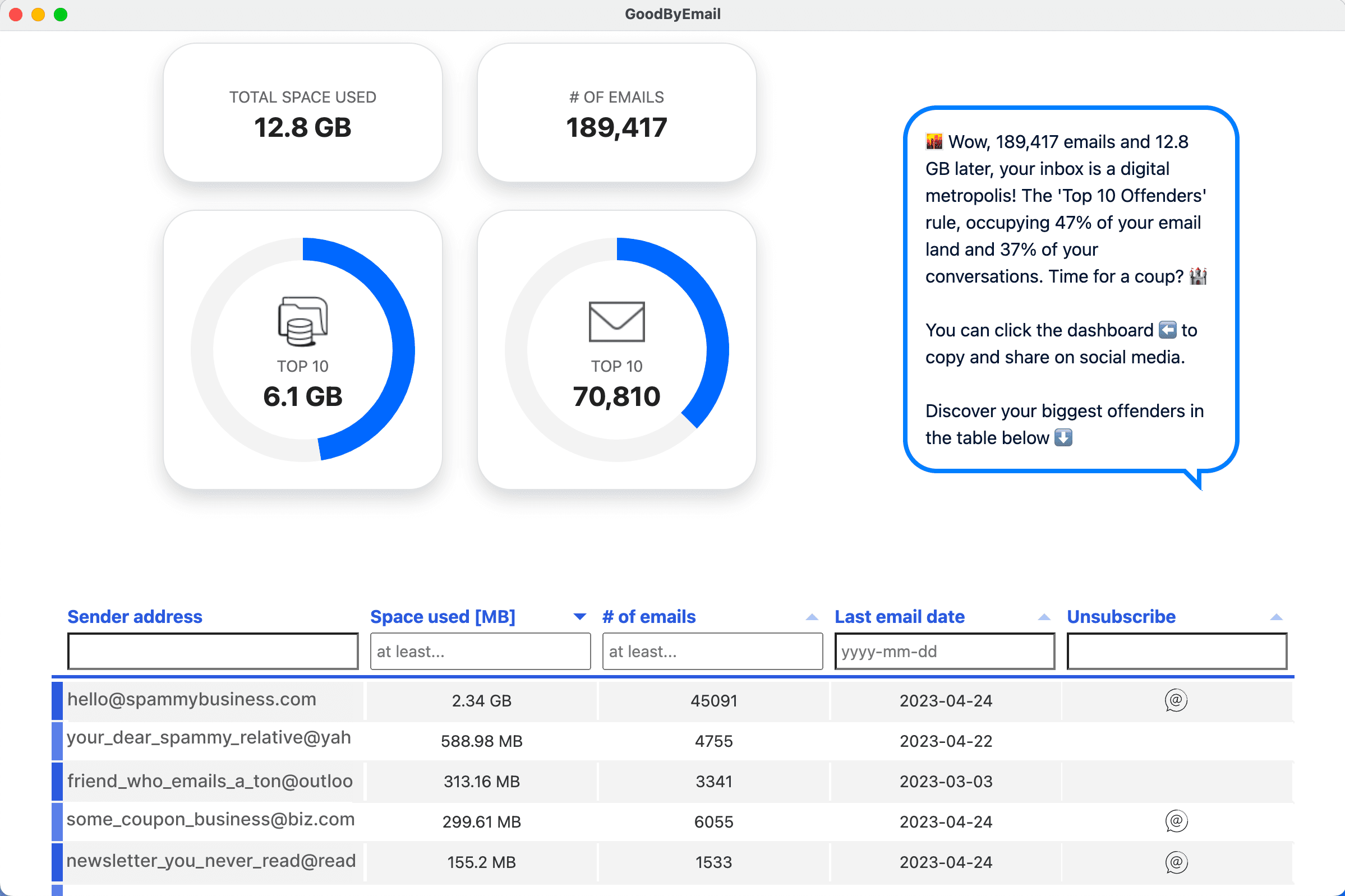
This list provides a powerful tool for inbox decluttering. This list is conveniently pre-sorted for you, showing all your senders ranked by the total storage space used by their emails. But you can also switch the sorting to show the number of emails received. No matter the sorting method, simply note down the senders you want to say goodbye to!
Additionally, with GoodByEmail, you can identify which of these senders are mailing list senders and easily unsubscribe from them, preventing unwanted emails from piling up in your inbox in the future.
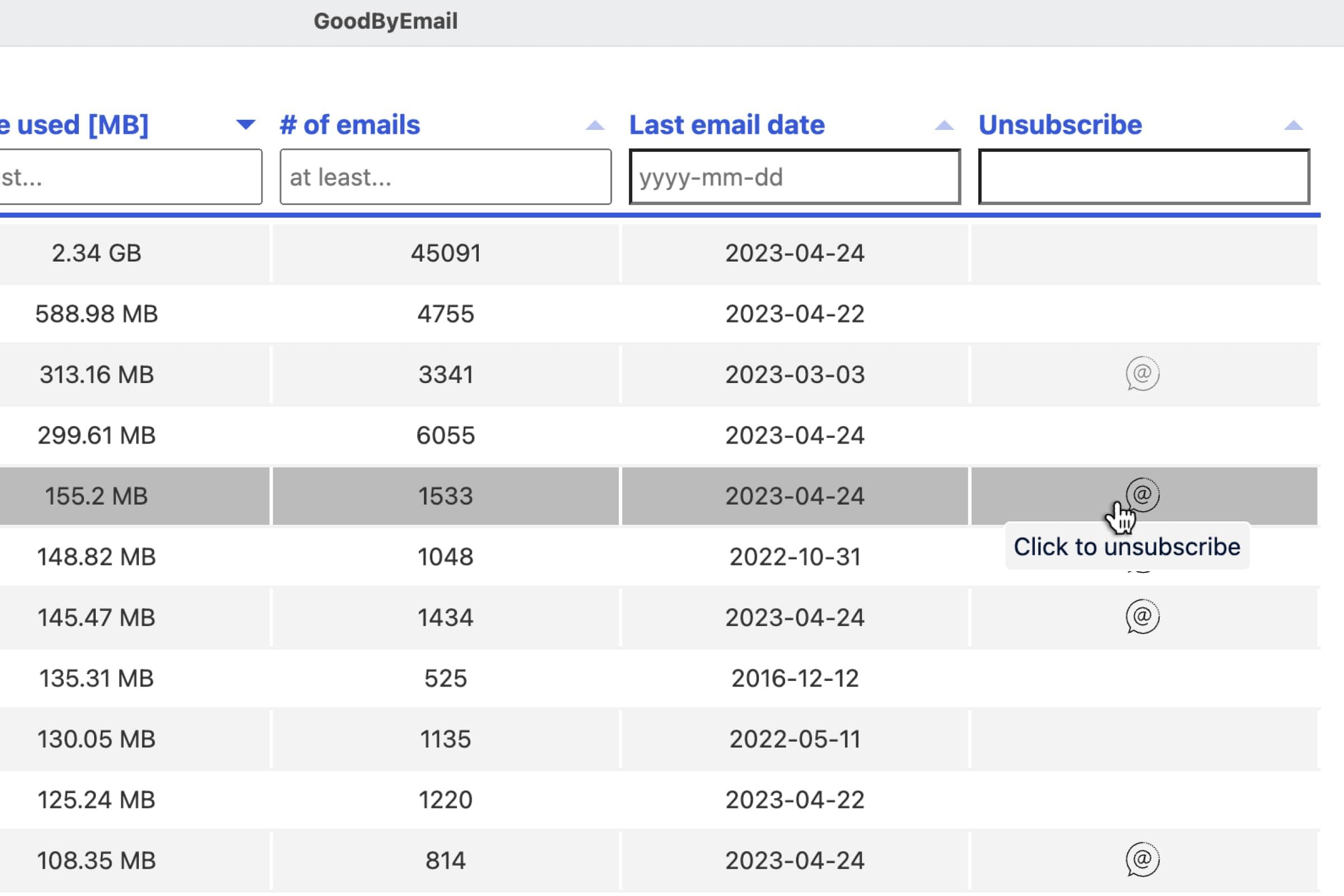
With those notes at hand, let's start mass deleting our Top Offenders! Go back to Gmail and search for those senders.
Select their emails, then click the little checkbox icon at the top left. This will select the first page of emails from that sender, not all the emails from that sender. After you select the emails on the first page, and want to select all emails from that sender you can click the link "Select all conversations that match this search". You will then get the confirmation "All conversations in this search are selected."

You can now move on to deleting emails! Click the little trash-can icon to put all these emails in the trash. Once you confirm, poof! Those emails are gone… sort of.
Don’t forget to also unsubscribe from any unwanted mailing lists using GoodByEmail to ensure you don’t receive any more unnecessary emails from them in the future.
Gmail has just moved your emails to the Trash folder. You can find your deleted emails in the Trash folder on the left side. Google kindly gives you 30 days to recover any email you didn't mean to delete. If you're sure, click the "Empty Trash now" message at the top of your Trash email list to get rid of those emails forever. But be careful, once they're gone, they're really gone!
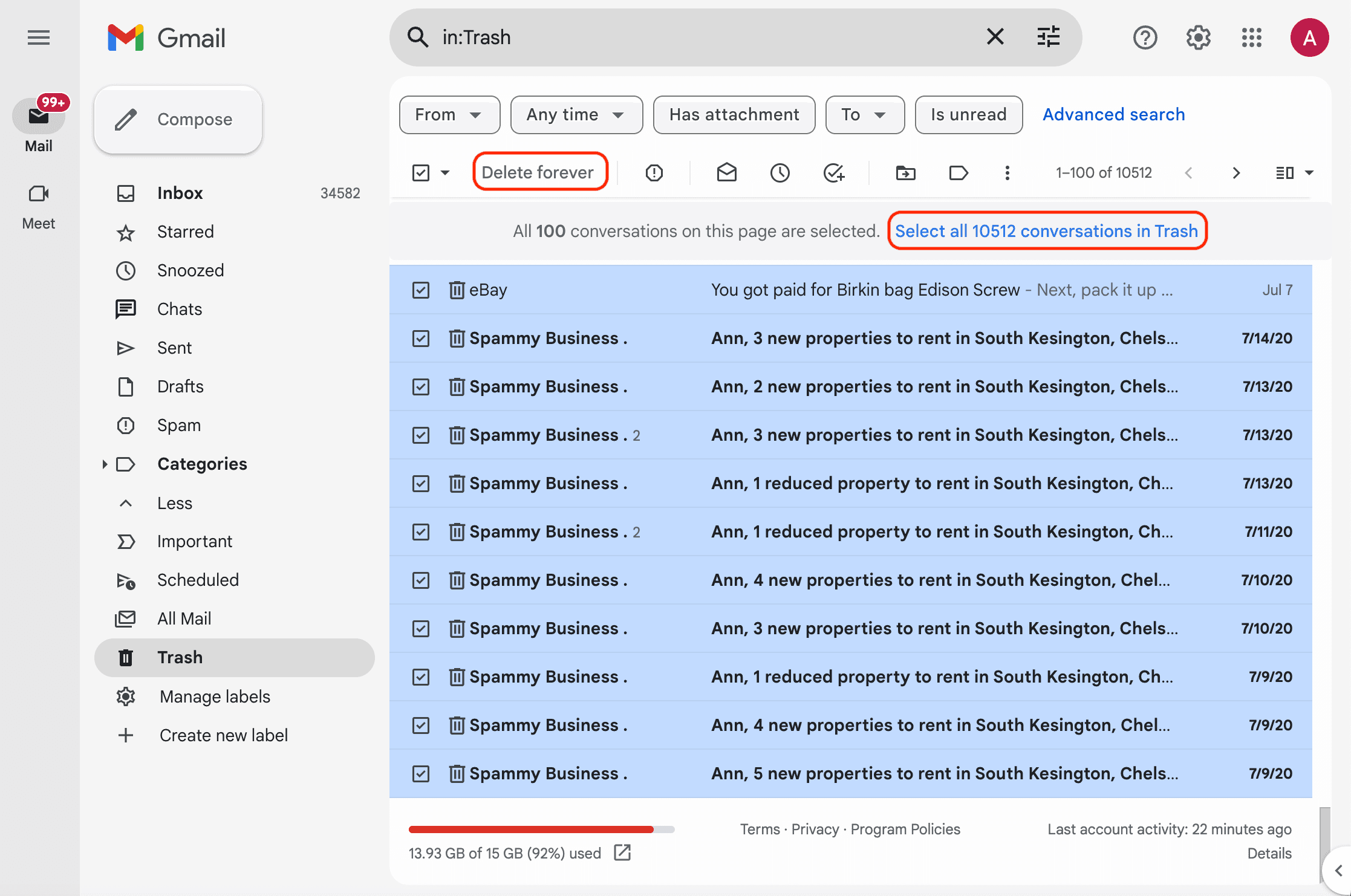
After those emails are gone from your inbox and the Trash folder, wait a day for Gmail to update things. Then, you'll have a lot more storage space!
With these helpful tips, you're on your way to a cleaner Gmail inbox. By not only deleting unnecessary emails, but also unsubscribing from unwanted mailing lists. Have fun cleaning!
Feeling a bit overwhelmed? Don't hesitate to reach out - we're happy to help!
FAQs: Your Burning Questions Answered
- Start by organizing your emails into folders or labels based on their importance or category.
- Regularly delete promotional emails, spam, and other non-essential messages.
- Unsubscribe from newsletters or mailing lists that you no longer find valuable.
- Set up filters or rules to automatically sort incoming emails, reducing clutter in your main inbox.
- Periodically review and clear out old emails, especially those with large attachments.
- Consider using tools like GoodByEmail. It not only helps in identifying and deleting the largest storage-consuming email senders (aka "Top Offenders"), but also aids in unsubscribing from mailing lists, ensuring your inbox remains organized and clutter-free.
- Begin by deleting unwanted emails, especially from the "Promotions" tab.
- Use Gmail's search and filter features to locate large emails. E.g use the search operator larger:10M to find emails with attachments larger than 10MB.
- Delete the emails you no longer need to free up storage space.
- Consider using tools like GoodByEmail. It's a specialized tool that helps you quickly identify email senders that consume significant storage (aka "Top Offenders"). Moreover, GoodByEmail assists in unsubscribing from mailing lists, reducing the chances of your inbox getting overloaded quickly. The best part is that it doesn't require access to your passwords, logins, or OAuth tokens, ensuring your privacy and security.
- Emails in Gmail: Start by deleting large emails with attachments, especially those in the "Promotions" and "Spam" tabs.
- Google Drive Files: Remove old documents, presentations, spreadsheets, and especially videos or large files that you no longer need.
- Google Photos: Delete photos and videos that are of low quality or duplicates. Remember, high-resolution photos and videos consume more storage.
- Downloaded Attachments: Check your "Downloads" folder in Google Drive for any old or unnecessary attachments that you might have saved.
- Trash/Bin: Items deleted from Google Drive and Gmail aren't immediately removed. They go to the Trash or Bin. Make sure to empty it to reclaim the storage.
- Consider using tools like GoodByEmail. It helps you quickly identify email senders that consume most of your Gmail storage. With this information, you can delete emails that significantly impact your storage. Furthermore, GoodByEmail assists in unsubscribing from mailing lists, preventing your storage from filling up rapidly in the future. It operates without requiring access to your Gmail credentials, ensuring the privacy of your data.
- Not all emails are created equal. Emails with large attachments, such as videos, high-resolution images, or documents, can take up a significant amount of space. However, these types of emails might not be as common in your inbox.
- On the other hand, while individual emails without attachments might seem insignificant in size, having thousands of them can cumulatively occupy a substantial amount of storage.
- Tools like GoodByEmail can be invaluable in this process. It helps you quickly identify and delete all emails from the "Top Offenders", i.e. senders that are occupying the most storage. Moreover, it aids in unsubscribing from unwanted mailing lists, preventing future storage issues. The best part? It does all this without requiring access to your sensitive login credentials.
- Use the Search Bar to locate the emails you want to delete.
- Click on "Select all conversations that match this search."
- Click the "Delete" button.
- Don't forget to empty your trash box to permanently remove the emails. It may take up to a day for the storage space change to be reflected in your account.
- If you're looking for a tool to identify the largest email senders, GoodByEmail is a unique tool in the market. It helps you quickly discover these Top Offenders without requiring access to your passwords, logins, or OAuth tokens.
- Deleted emails are moved to the "Trash" folder and remain there for 30 days.
- To free up storage immediately, you need to manually empty the "Trash" folder.
- After emptying the trash, it might take up to a day for Gmail to update and reflect the new storage space.
- The Google One Storage Manager recommends deleting emails with large attachments and provides suggestions to free up storage used by other Google services like Google Drive and Google Photos.
- While it's a helpful tool, it's essential to note that in many cases, the primary culprits consuming Gmail storage are thousands of small emails, not just the ones with large attachments.
- For a more in-depth analysis, GoodByEmail is a specialized tool that identifies these Top Offenders. The best part? It ensures your privacy by not requiring Gmail credentials or OAuth tokens.
- Start with the Basics: Before diving into specialized tools, begin by manually deleting old, unnecessary emails, especially those with large attachments. Remember, emails in the "Promotions" or "Spam" tabs can often be deleted without much thought.
- Empty the Trash: Deleted emails remain in the "Trash" folder for 30 days. Make it a habit to empty this folder regularly to free up storage immediately.
- Use Google's Tools: Google One Storage Manager can suggest which emails and files to delete across Gmail, Google Drive, and Google Photos.
- Third-Party Tools: For a more detailed cleanup, consider using specialized tools. One such tool is GoodByMail. For a detailed guide on how to use it effectively and safely, check out this article. It provides a privacy-first approach to cleaning up your gmail inbox without compromising your personal data.
- Regular Maintenance and Unsubscribing: To prevent your Gmail storage from filling up quickly in the future, consider setting aside time once a month for a quick cleanup. Additionally, GoodByEmail assists users in unsubscribing from unwanted mailing lists, which can significantly mitigate the risks of inbox overload. This proactive approach not only frees up storage but also ensures a clutter-free inbox experience.
- Check the Trash Bin:
- Go to Gmail.
- On the left panel, click on 'More' to expand the list of options.
- Select 'Trash' (emails here are only available for 30 days after deletion).
- Look for the email you need to recover.
- Once found, open it and click on the "Move to" icon to restore it to your Inbox or a specific folder.
- Visit the official Google Support page on recovering deleted emails.
- Use the Gmail Message Recovery Tool:
- If your email is not in the Trash Bin and it’s been less than 30 days since you deleted it, Google provides a Gmail Message Recovery Tool.
- Visit the official Gmail Message Recovery Tool website and follow the prompts.
What is the best way to clean up email?
What is the best way to clean up email?
How do I free up my Gmail storage?
How do I free up my Gmail storage?
What can I delete when Google storage is full?
What can I delete when Google storage is full?
Will deleting emails free up storage?
Will deleting emails free up storage?
How can I bulk delete thousands of emails in Gmail at once?
How can I bulk delete thousands of emails in Gmail at once?
Why is my Gmail storage full even after deleting thousands of emails?
Why is my Gmail storage full even after deleting thousands of emails?
Does Google offer a cleanup tool for Gmail?
Does Google offer a cleanup tool for Gmail?
Do you have a comprehensive guide on how to safely clean emails and free up a significant amount of Gmail storage?
Do you have a comprehensive guide on how to safely clean emails and free up a significant amount of Gmail storage?
How can I safely archive, backup, or export my email inbox without granting third-party access to my data?
How can I safely archive, backup, or export my email inbox without granting third-party access to my data?
What are the steps to recover deleted email in Gmail?
What are the steps to recover deleted email in Gmail?
Clean up your email inbox with way less effort. Check out GoodByEmail and discover why your inbox is out of storage. With GoodByEmail's help you can mass-delete emails from unwanted top offenders and unsubscribe from undesired mailing lists with a single click. It's the only truly secure option on the market, your emails never leave your device.
Quick plug: Clean up your email, privacy-first 💪
Isn’t it frustrating to constantly receive that "Your storage is 95% full" message?
Scared of using Email Cleaning, Unsubscribe or Declutter tools that snoop around your emails, even though they swear they are safe?
We got your back! If you haven’t tried GoodByEmail, it’s about time. Not only does it identify which email senders—many of whom you likely don’t care about anymore—are consuming all your storage space, but it also allows you to effortlessly unsubscribe from mailing lists with complete safety!
GoodByEmail uses a unique privacy-first approach by design: It simply cannot connect directly to your email provider. It does not require you to share any logins, credentials, oauth tokens, nor any sort of invasive permissions whatsoever. All the processing happens on your computer and no emails are ever uploaded to GoodByEmail's servers. Plus, you can even use it offline for maximum privacy!
Could you really trust other cleaning solutions available in the market, knowing they have direct access to your emails? Some services monetize by selling your data. Even if they claim it's secure, it raises concerns about the accessibility and potential misuse of your personal information.
GoodByEmail works with every email provider, you name it: Google, Microsoft, Fastmail, AOL, Yahoo Mail, iCloud, Office 365, Outlook, Zoho, Bluehost Mail, Namecheap Mail, Alibaba Mail, Alimail, Alyun, Gmail, Mail.com, Comcast Xfinity, Live, Hotmail, Yandex Mail, G Suite, MSN, Godaddy Mail, GoogleMail, and so many more.
You only need to make a one-time secure export of your inbox in mbox or .pst format, and GoodByEmail will find out who are the senders eating up your inbox storage space, without anyone else getting a look at your emails. Plus, you can also easily unsubscribe from those pesky subscription emails. It’s easy to do! Need help? This guide has a step-by-step.
So, what did you like about this post? Come say hello on X!
Loading X...
Wondering where to find us?
Follow us on X:
